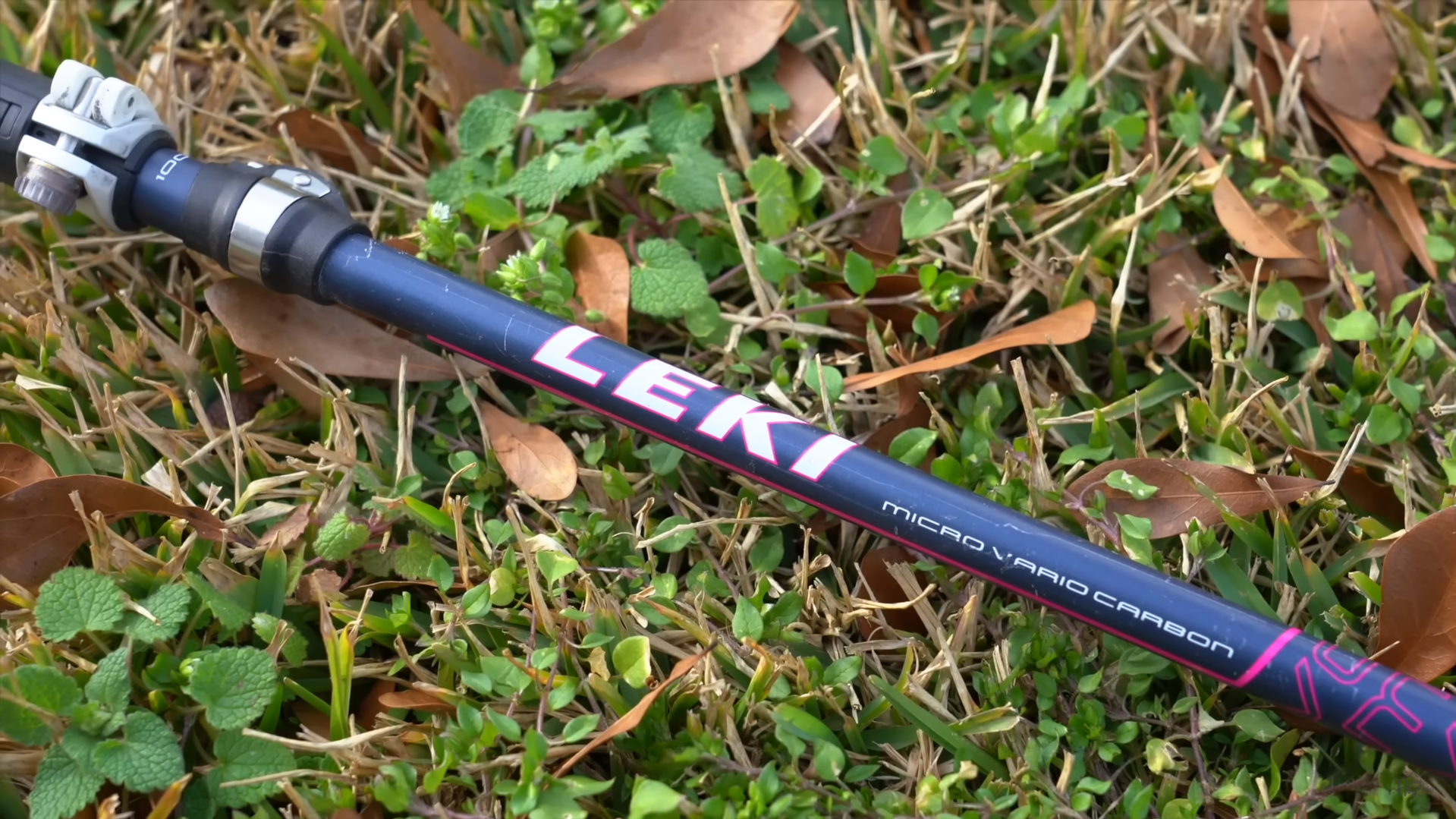If you are looking for a trekking pole to support your outdoor activities, chances are you have come across the terms “aluminum” and “carbon fiber”. You know one is lighter than the other, but what is the difference really? This blog post provides useful information on aluminum and carbon fiber poles. It will equip you with the knowledge needed to determine which type is best for your needs!
Why Use Trekking Poles?
If enjoy hiking or walking outdoors, consider adding trekking poles to the gear. They can be very helpful. They provide extra stability and help distribute body weight more evenly, reducing strain on the joints. They can also help reduce fatigue by providing additional support to your arms.
There are two main materials used in their construction: aluminum and carbon fiber. Each has its own benefits and drawbacks.

Aluminum Poles
Aluminum trekking poles are the most commonly used type. They are lightweight, durable, and affordable. Aluminum is also a great insulator and can help keep your hands warm in cold environments. Aluminum poles are stable on trails and can have a long lifespan with proper maintenance.
Aluminum poles generally come in two different varieties — fixed length or adjustable length. Fixed length poles are cheaper but must be cut down to size for each individual user; whereas adjustable length poles allow you to adjust the height according to your needs on the trail. Both types are lightweight and easy to carry, but adjustable ones offer more maneuverability.
If you’re on a budget or new to hiking, aluminum poles would be a good choice for you. They’re durable enough to last you several seasons of use and provide plenty of stability on the trail. However, they may not be as strong as carbon poles, so it’s important to treat them with care.
Pros
- Lightweight and durable
- Affordable compared to other materials
- Good insulation properties for cold environments
- Fixed or adjustable lengths available
Cons
- Not as strong as carbon fiber ones
- Prone to breaking if not cared for properly.
When to Use Aluminum Trekking Poles
Aluminum trekking poles are a traditional choice for many hikers because they tend to be more affordable. Aluminum is also heavier, which makes it more stable when placed into the ground and can provide better support for heavier individuals. Additionally, aluminum is quite sturdy and durable and will typically stand up against wear and tear on the trail.
Carbon Fiber Poles
Carbon fiber poles are a great option as they provide lightweight and strong support. They’re also highly adjustable, making them ideal for different hiking terrain. Carbon poles are more expensive, though this can depend on the manufacturer.
However, if you plan on using your trekking pole in colder climates, it may be best to opt for an aluminum pole instead. Carbon fiber can become brittle in the cold and break easily, so it’s not ideal if you plan on using your poles in subzero temperatures.
Overall, carbon poles are an excellent choice for those wanting lightweight and adjustable poles with good shock absorption. Just make sure that they’re suited for the climate you’ll be hiking in before investing in them!

Pros
- Lightweight and strong
- Highly adjustable
- Absorbs shock when walking on rocky terrain or hard surfaces
- Less prone to bending or breaking compared to aluminum
Cons
- Can become brittle in cold climates, making them less suitable for subzero temperatures
- More expensive (depending on the manufacturer)
When to use Carbon Fiber Poles
If you want the lightest weight option, carbon poles are great for hiking. Carbon fiber is extremely lightweight, and this makes it ideal for day hikes or long backpacking trips when you need to minimize weight as much as possible. It is also very strong, so it can easily take on rough terrain without breaking or bending. [1]
It’s also not a shock absorbent, so you won’t get the same dampening effect from hard terrain. Thus, carbon poles are best used in areas where weight is the priority and shock absorption isn’t necessary.
The Differences
Hikers, backpackers, and travelers commonly use aluminum or carbon trekking poles for dependable support while on trails.
Aesthetically, they are very different. Aluminum poles have a smooth finish that makes them lightweight but durable. Carbon poles have a sleek appearance because of their woven patterns with reinforced fibers layered together. This gives them an edge in strength despite being lighter than aluminum models.
Both types usually come with adjustable lengths that allow you to choose the right length based on your height and the terrain you’re tackling. But when it comes to adjustability, carbon poles have the advantage because they are typically easier to adjust.
Overall, both materials offer excellent support and stability whether you’re hiking on flat terrain or taking on technical trails with steep inclines. Choosing between diverse types of poles ultimately depends on personal preference, as each type has its own advantages and disadvantages. However, keep in mind that carbon models are often seen as superior due to their lightweight construction and adjustable length making them suitable for a variety of terrains.
No matter which type of pole you choose, make sure to take proper care and maintenance steps to keep them in good condition for years to come. Happy hiking!

How To Choose The Best Trekking Pole for You
Now it’s time to choose the right one for you. Here are some tips to help make your decision easier:
- Consider your budget.
- Think about your terrain: If you will be traveling through difficult or rocky terrain then carbon poles may provide more stability and durability.
- Test out different options: Whenever possible, try out diverse types of poles before making a purchase to get a better idea of how they feel in your hand.
- Make sure the pole is comfortable: Always ensure that the handle fits comfortably in your hand and that the straps are adjustable enough to accommodate different arm lengths. [2]
By considering all these factors, you can ensure that you choose the right pole material for your needs!
Maintenance Tips For Aluminum And Carbon Fiber Trekking Poles
Pro maintenance will ensure the durability and dependability of your poles during all your expeditions. Here are some helpful tips:
- Clean off dirt and debris from your poles after each hike using a soft cloth or brush. Avoid abrasive materials as this can damage the finish of the pole or weaken its structure over time.
- Store your trekking poles indoors when not in use. Prolonged exposure to moisture or extreme temperatures can damage the poles, so keep them away from any elements that could harm them.
- Check for loose screws and bolts before and after each hike. If you notice any looseness, tighten them with a screwdriver or Allen key.
- Inspect the tips of your trekking poles regularly for wear and tear. Replace worn tips as soon as possible to avoid slipping on slippery surfaces or uneven terrain.
- Keep your trekking poles well-oiled with light machine oil to ensure smooth operation and help prevent rusting. [3]
Additional Tips
When you’re trying to figure out which type of pole to buy, there are a few additional tips that can help guide your decision.
First, consider the weight difference between poles. If you plan on hiking long distances or carrying your poles for long periods of time, then lighter models may be more suitable for you. If you’re looking for something with more durability and stability, then a heavier aluminum model might be right for you.
Lastly, it’s important to consider your budget when selecting a pole. Aluminum poles are typically less expensive, so if you’re on a tighter budget then aluminum might be the way to go. But if you plan on using your poles for more extreme conditions or longer distances, then investing in a higher-quality carbon fiber model can be worth the extra money.
Whether it’s an aluminum model or a carbon fiber one – just make sure you choose something that fits your style and budget!
FAQ
Are carbon fiber hiking poles better than aluminum?
It really depends on weight, strength, and price. Carbon poles tend to be lighter, but they can also be significantly more expensive. Aluminum poles are stronger and more durable, making them better for tougher terrain. If you’re looking to save some weight in your pack without sacrificing too much strength or durability, then carbon fiber might be the way to go. Also keep in mind that some trails may require you to use specific types of hiking poles – ensure that you check with your local park or forest service before embarking on a trek! [4]
What is the best material for hiking poles?
When it comes to choosing the best material for hiking poles, there are two main contenders: aluminum and carbon fiber. Both materials have their advantages and disadvantages, so it’s important to consider each one before making a purchase.
Aluminum is a lightweight metal that is often used in poles due to its affordability and durability. It can withstand tough terrain without bending or breaking, and its weight makes them easy to transport in a backpack or on your person. However, aluminum poles are not as light as carbon fiber ones, which can be a drawback if you need extra weight savings while carrying equipment over long distances.
On the other hand, carbon fiber is an incredibly strong material that is much lighter than aluminum. It is also less likely to bend or break, which can be beneficial when you are travelling over difficult terrain. While carbon poles tend to be pricier than aluminum poles, their weight reduction properties can make them a worthwhile investment for extended hiking and backpacking excursions.
When it comes down to it, you have to choose the material that fits your needs the best. If you will be trekking in challenging conditions then carbon fiber may be a better option due to its strength and lightness. On the other hand, if affordability is important and you won’t encounter too many harsh conditions then aluminum may be a better choice.
Regardless of which material you decide to go with, both types of poles can help improve stability on uneven terrain while reducing strain on your legs and back. It is best to test out the different materials before purchasing so you can get a feel for how they handle in the field. [5]
No matter which trekking pole material you decide to go with, make sure it is comfortable and equipped with features that will support your specific needs. This way you can enjoy a safe and enjoyable experience while exploring the great outdoors!
Which is better: carbon fiber or aluminum?
There is no single answer for which material is best for you. Aluminum is typically heavier but also more affordable. Aluminum poles are also very durable and can take a lot of force without breaking. They’re generally less shock absorbent than carbon poles, however, meaning that they may not be the best choice if you plan on using them over rough terrain or in high-altitude climates.
Carbon poles are lighter than their aluminum counterparts and offer greater shock absorption. This makes them a great choice for hikers who plan on using their poles in rougher terrain or higher elevations. However, they are usually more expensive and can be more prone to breakage than aluminum poles if they’re used incorrectly.
If you’re looking for an affordable option that is strong and durable, then aluminum poles may be the best choice for you. But if you need something lightweight with good shock absorption, then carbon fiber might be the way to go. Whichever one you choose, make sure you take into consideration your budget, planned use, and personal preferences when making your decision.
Are carbon trekking poles the best?
When it comes to trekking poles, there’s no single “right” choice. It all depends on your preferences and the type of terrain you’ll be navigating. However, it is true that carbon poles have some definite advantages over aluminum ones.
For starters, carbon poles are usually lighter than their aluminum counterparts. This makes them easier to carry around when you’re off on a long hike or backpacking trip. They also tend to flex more with each step you take, absorbing shock better while providing greater stability and balance during those challenging stretches of rough ground. On top of that, they tend to last longer than aluminum poles since they don’t corrode or rust like metal can when exposed to wet conditions for long periods of time.
That said, carbon trekking poles aren’t necessarily the “best” choice for every situation. For instance, if you’re planning to be trekking through thick undergrowth or on rocky trails where you need more support and stability, aluminum poles may provide a better option since they are stronger and stiffer than carbon ones. On the other hand, if you plan to use trekking poles in snowy conditions or over muddy terrain, then carbon might be the way to go due to its greater resistance to corrosion and rusting caused by moisture.
Ultimately, it’s up to you to decide which type of pole is best suited for your particular needs. Be sure to consider your budget as well: aluminum poles are typically more affordable, so if you’re on a tight budget, that might be the way to go.
Useful Video: My New Favorite Trekking Poles (Black Diamond Alpine Carbon vs Leki Micro Vario vs Zpacks UL)
Conclusion
To summarize, the choice between aluminum and carbon fiber trekking poles ultimately depends on individual preferences. Aluminum is generally the more affordable option and offers great stability and support on uneven terrain. On the other hand, carbon poles are lighter and offer better shock absorption. Both materials will serve you equally well for many years of use if taken care of properly. Ultimately, it’s important to do your research and find the right pole for your specific needs – as this could make a huge difference in your overall enjoyment of hiking!
Whichever material you choose, just remember to always take precautions no matter where you’re trekking, look out for any potential hazards or animals nearby, and enjoy yourself during all of your adventures! Happy trekking!
References:
- https://cascademountaintech.com/blogs/news/which-is-better-aluminum-or-carbon-fiber-trekking-poles
- https://www.rei.com/learn/expert-advice/trekking-poles-hiking-staffs.html
- https://trekology.com/blogs/how-to-series/how-to-clean-and-maintain-your-trekking-poles
- https://wheretheroadforks.com/carbon-fiber-vs-aluminum-trekking-poles-pros-and-cons/
- https://www.switchbacktravel.com/how-to-choose-trekking-poles












Leave a Review